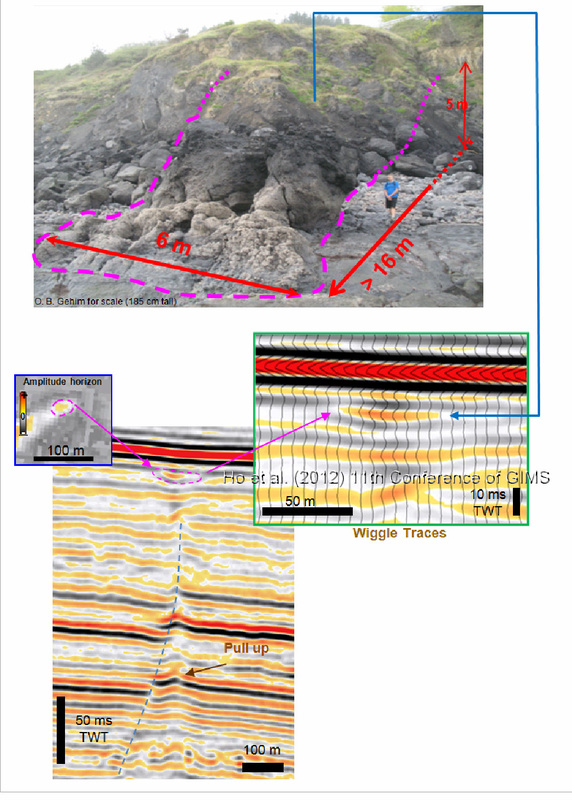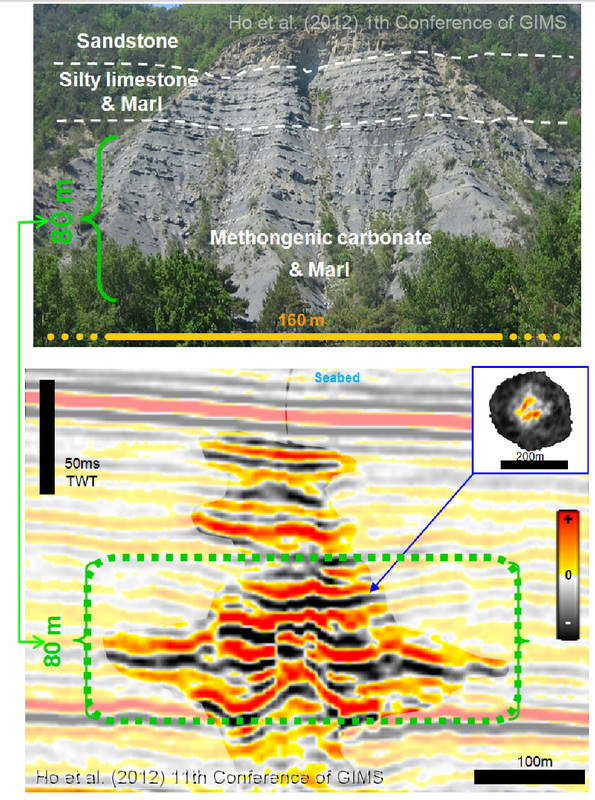
Seep carbonates: seismic expression vs. outcrop observations
Sutieng Ho1, Patrice Imbert2, Jean-Philippe Blouet3
(1) (Previously) 3D Lab, Cardiff University, CF10 3YE, Cardiff, United Kingdom (2) Total CSTJF, avenue Larribau, 64018 Pau, France; patrice.imbert@total.com; (3) (Previously) Ecole Nationale Supérieure de Géologie, Rue du Doyen Marcel Roubault, 54500 Nancy, France;
In this study we compare the expression of seep carbonates as high-amplitude patches on seismic data with the ground truth of outcrop analogues. The organizations of two different outcrops of methanogenic carbonates were compared with the positive high amplitude anomalies (PHAAs) that we observed in a high resolution 3-D seismic survey in Offshore Angola.
On seismic records, patches of positive high-amplitude anomalies commonly occur in the middle of hemipelagic series in continental slope settings. Individual PHAAs are typically sub-circular or elongate, and stack up vertically over several hundred meters in some cases. PHAAs associated with acoustic chimneys or pockmarks, have been studied on a 3-D seismic survey of Offshore Angola. They correspond to seismically fast and high-impedance material, and often generate seismic pull-up effects. In the context of soft background, deep-sea sediments, such in our 3-D seismic survey, PHAAs are interpreted as methanogenic carbonates.
Two outcrops of methanogenic carbonates in NW Spain (Mutriku, Kardala outcrop) and in SE France (Gigors) indicate that the lithologies that compose the methanogenic carbonates are rather heterogeneous:
1) The Kardala carbonate lens (over 30-m long and 5-m thick) reported by Agirrezabala (2009) in Mutriku is located above a fault, and is comparable with the smallest elongate PHAA seen on our survey, both as regards the size and the location above a fault (Fig. 1). The Kardala lens is composed by the aggregation of: oil-stained or bitumen-filled methanogenic carbonate nodules/conduits, either isolated or clustered, carbonate cements and benthic macrofossils.
On seismic records, patches of positive high-amplitude anomalies commonly occur in the middle of hemipelagic series in continental slope settings. Individual PHAAs are typically sub-circular or elongate, and stack up vertically over several hundred meters in some cases. PHAAs associated with acoustic chimneys or pockmarks, have been studied on a 3-D seismic survey of Offshore Angola. They correspond to seismically fast and high-impedance material, and often generate seismic pull-up effects. In the context of soft background, deep-sea sediments, such in our 3-D seismic survey, PHAAs are interpreted as methanogenic carbonates.
Two outcrops of methanogenic carbonates in NW Spain (Mutriku, Kardala outcrop) and in SE France (Gigors) indicate that the lithologies that compose the methanogenic carbonates are rather heterogeneous:
1) The Kardala carbonate lens (over 30-m long and 5-m thick) reported by Agirrezabala (2009) in Mutriku is located above a fault, and is comparable with the smallest elongate PHAA seen on our survey, both as regards the size and the location above a fault (Fig. 1). The Kardala lens is composed by the aggregation of: oil-stained or bitumen-filled methanogenic carbonate nodules/conduits, either isolated or clustered, carbonate cements and benthic macrofossils.
2) The vertical succession (over 80 m) of well continuous methanogenic carbonate layers in Gigors (Fig. 2) also shows heterogeneity both horizontally and vertically (see also Blouet et al., this volume). The carbonate layers are not pure but contain shale or coarse grained sands, macro and microfossils. Their individual thickness is less than seismic resolution, which means that seismic would respond in this configuration primarily to the stacking pattern of the beds. The soft / hard alternations could be similar to stacked anomalies observed offshore Angola.
Our outcrop observations point out that within the limit of typical seismic resolution, the lithology of methanogenic carbonate is commonly heterogeneous. Variation in the lithology of both the carbonates and encasing shales (presence of silt / sand / shale) in the carbonates and variable carbonate content of the marls will further affect the response by modifying acoustic impedance.
All of these inspire that, impedances of PHAAs vary in seismic data, depend on the vertical organization of the hard (carbonates) layers and their vertical spacing, but also lithological characters and heterogeneous compositions of the hard (carbonates) layers.
Forward seismic modeling in progress will provide additional insight in the actual effect of heterogeneity in the bedding, and may help interpreting the actual lithology behind our seismic records, at least the variability that may be involved.
__________________________________________________________________________________________________________________________________________________
References
Agirrezabala, L. M., 2009. Mid-Cretaceous hydrothermal vents and authigenic carbonates in a transform margin, Basque-Cantabrian Basin (western Pyrenees): a multidisciplinary study. Sedimentology, V. 56, p. 969-996
Blouet, J. P., Imbert, P., Ho, S., this volume. Morphology variations of methanogenic carbonates in relationship with their genesis mechanisms, Vocontian Basin, France: a multidisciplinary study.

Fluid-Venting-System website by S. HO is licensed under a Creative Commons Attribution-NonCommercial-NoDerivatives 4.0 International License.


